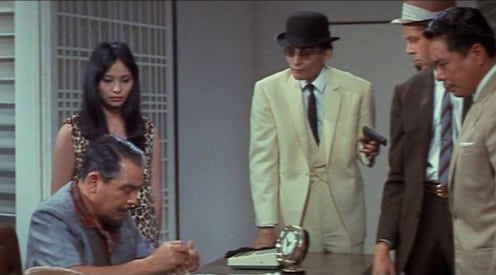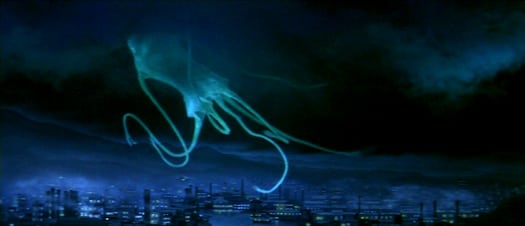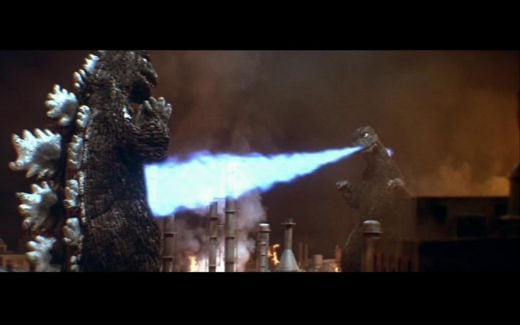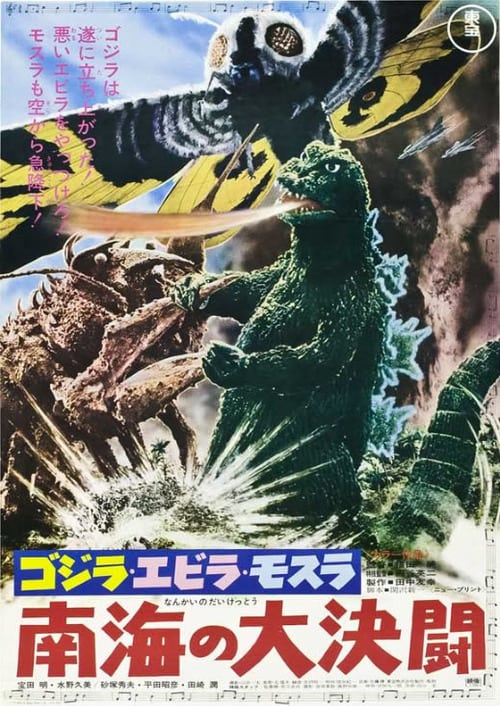Dogora (1964)
Directed by: Ishirô Honda
Written by: Jôjirô Okami, Shinichi Sekizawa
Starring: Hiroshi Koizumi, Nobuo Nakamura, Yoko Fujiyama, Yosuki Natsuke
HCF REWIND NO.119. DOGORA AKA UCHU DAIKAIJU DOGORA, DOGORA THE SPACE MONSTER, DAGORA THE SPACE MONSTER [Japan 1964]
AVAILABLE ON DVD
RUNNING TIME: 83 min
REVIEWED BY: Dr Lenera, Official HCF Critic
Some TV satellites are being destroyed around the world by a pulsating blue space amoeba called Dogora. Meanwhile a gang of jewel thieves are in the midst of cracking a safe when they are lifted off the ground and suspended in mid-air. On their trail is Detective Kommei, while at the same time a mysterious American, Mark Jackson, steals some fake diamonds created by Dr. Munakata, who believes he can revolutionise their industrial use, and clashes with the gang. As the crooks plan their next job, Munakata and his assistant Musiyo, deduce that Dogora is a space cell transformed by radioactivity into a monsters which feed on carbon-based substances like coal, diamonds and, possibly to be next, humans…..
Like Gorath, Dogora is a fairly obscure Toho entry despite coming from the winning team of producer Tomoyuki Tanaka, director Ishiro Honda, writer Shinichi Sekizawa and composer Akira Ifukube who were involved in many of their classic movies. Unlike Gorath, it has had a proper R1 DVD release, but like Gorath I only caught up with it recently. Generally regarded as one of Honda’s poorer efforts, with much criticism about the way the monster story is often ignored in favour of a tale about gangsters, it’s still quite a fun watch, and complaints about an overly slow pace don’t really hold water when a few of the Godzilla films move just as slowly in their first third or even half. It has something of a rushed feel and lacks focus, sometimes seeming like it was meant to be a comedy but in a half-hearted way, but it’s a more interesting and enjoyable movie than Varan The Unbelievable, for example, and maybe the later Space Amoeba too.
As was common practice, Shinichi Sekizawa fashioned a script from an original story submission by Jojiro Okami. The cast for Dogora included, unusually, an American performer in a major role. When a role for a ‘white’ person was required, Toho often just pulled people off the street, which explains the generally poor standard of acting whenever a ‘white’ person shows up. Robert Dunham, though not trained as one, was actually quite a good actor, could also speak fluent Japanese, and appeared in a lot of Toho films including Mothra and Godzilla Vs Megalon [his most famous role]. The production of Dogora was rushed because Toho fast-tracked the next Godzilla film Ghidorah The Three-Headed Monster, which partly explains the unevenness of the finished film. Toho liked Dunham’s character Mark Jackson, a character not unlike James Bond, and intended to make some more films featuring him, but Dogora was a commercial disappointment, and, like Matango, went straight to TV in the US. This version is not cut or re-edited, but Dogora was changed to Dagora [supposedly because they were worried people would think the film was about a dog], and the dubbing is one of the worst dubbing jobs ever done to a Toho picture.
So it’s monsters and gangsters then, but if you’re expecting a serious, even dark, movie along the lines of The H-Man then you’re in for a shock, because Dogora is quite light-hearted for much of the time, especially concerning the gangsters. These criminals look very cool with their fedoras, sun-glasses and white hats, but are notably conspicuous, and not only that but are continually incompetent too. The only one who seems to be any good is the group’s moll Hamako, played with conviction by the lovely Akiko Wakabayashi [later to be in You Only Live Twice, and I was pleased to notice whilst watching Dogora that she wasn’t dubbed for the 007 pic], though she seems to have an agenda of her own. Detective Kommei, on the trail of these crooks, also seems to be a bit of an idiot; in one totally random bit he fires party-streamers out of his gun. Then you have the enigmatic American Jackson, continually besting both Kommei and the gangsters. We are kept in the dark for ages as to whose side he is on, and I wasn’t even sure at the end. Though the action content featuring all these people is quite minimal in a film which certainly shows the influence of James Bond, all this is quite interesting and certainly moved fast enough to keep my attention even if for large stretches of the film I wondered why it was actually called Dogora, and whether the film actually needed any monsters at all, rather than the other way round.
Now despite the title there are actually lots of Dogora’s….sometimes. First of all Dogora is a giant amoeba floating through space, then a huge jellyfish/octopus combo that seems to live in clouds and occasionally comes out to feed on carbon and diamonds, then finally lots of seemingly smaller jellyfish/octopus combos. Dogora is not really explained convincingly but never mind, he’s a really unique monster creation from Toho, especially in his giant form, where he’s a really nightmarish and surreal sight hovering above Kyushu, even if it’s just a plastic model suspended upside down in a water tank while wires operate the tentacles. It’s quite eerie when he’s just in the clouds too, which light up in an almost psychedelic fashion. The film does link Dogora with the gangsters almost immediately by having Dogora foil their robbing plans twice, and despite what you may have read, he does cause quite a bit of havoc, sucking up coal, trucks and, in one striking moment employing cell animation, a whole bridge. The method employed for his destruction is very silly though and shows poor writing the way it is introduced, while in the climax Eiji Tsuburaya’s special effects look very cheap, with multiple wires visible, poor model work and the most unconvincing polystyrene boulders you’ll ever see. Akira Ifukube’s music tries very hard to make the sequence exciting and does partially succeed.
Despite containing lots of crooks, there’s no menace involving them and potentially tense scenes, like an escape from being tied up and a shoot-out on a beach, are slackly handled, sometimes with unusually poor framing from Honda and his cameraman Hajime Koizumi, and sometimes with moments where it’s hard to tell if things are supposed to be funny or are just badly done, like a guy half-lighting a cigarette with his foot. A couple of brief martial arts bits employ quick close-ups to try and disguise the lack of actual skill by the performers. There seems to be a budding romance between Kommie and Musiyo, and hints that we’re going to have Sekizawa’s favoured [it’s used in three Godzilla films] triangle of a girl, her boyfriend, and her brother who disapproves of the boyfriend, but this goes nowhere. Not enough time is really spent on any aspect of the story to really make it entirely work, and while there are references to the UN and the world working together to get rid of Dogora, you don’t get much of a sense of one of Honda’s favourite themes in this movie, but it’s never boring [despite what you may have read], and its awkwardness gives it considerable charm.
Hiroshi Koizumi seems bored in his role and, as with Atragon, Yoko Fujiyama is just bland and distant, though most of the rest of the cast are fun even if we never know much about their characters. Ifukube’s music, which employs the theramin and a menacing thumping noise whenever Dogora appears, mostly just repeats the same theme over and over again. One furious, busy piece develops one used at the beginning of Varan The Unbelievable. It’s one of Ifukube’s lazier scores, though he was probably rushed, and it’s interesting to note that he usually only had three or four days to do his scores, including writing, orchestrating and recording, which may explain why they are so repetitious and repeat bits and pieces from previous scores even if the films don’t relate to each other that much [for instant a theme used to describe a particular monster re-used in a later film to describe another monster]. Dogora may, in the end, be a heavily flawed effort where they didn’t really nail the concept, but it’s hard to dislike, and its ridiculousness is at times quite infectious.
Rating: 

















Be the first to comment